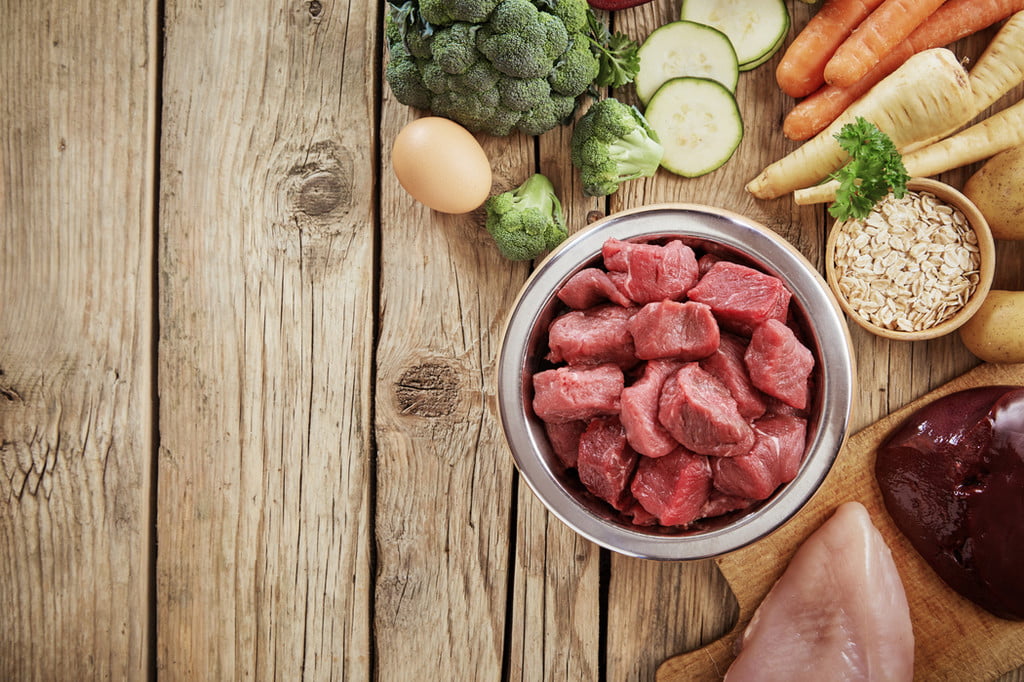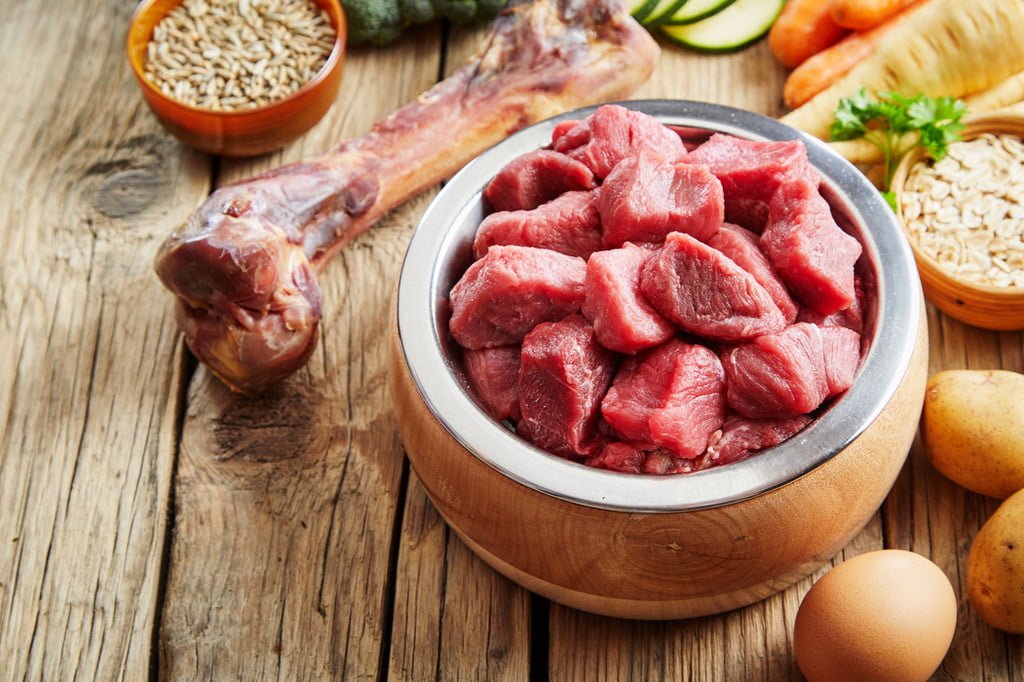
As a pet parent, you probably want to be feeding your dog the highest-quality and most healthy food possible — without having to spend a fortune. Leaving aside raw diets or specialty diets prescribed by a veterinarian or pet nutritionist, there are a growing number of companies advertising on the internet that offer “custom” dog food that caters specifically to your dog’s breed, age, weight, demeanor, and energy level.
Just some of the companies offering this type of subscription-based, custom-formulated dog food that gets delivered to your home are: PetPlate, The Farmer’s Dog, Just Right, Hungry Bark, Ollie, Just Food for Dogs, and Tailored Pet.
How custom-formulated dog foods are prepared
When you visit one of these dog food company’s websites, you’re asked to complete a detailed questionnaire about your dog. Upon completion, the website uses a proprietary algorithm to formulate a customized diet plan for your dog that includes a subscription-based kibble or wet food (depending on the company). Only then is the subscription (and per meal) price for the food disclosed, as the per-serving quantity and food type(s) will be specific to each pet.
What you’ll discover is that many of these custom-blended dog food companies boast about their superior-quality and human-grade ingredients, how the food is flash-frozen and then shipped right to your door in preportioned containers, and how the food is formulated specifically for your dog (based on your questionnaire responses).
Regardless of which dog food service you subscribe to, expect to pay a premium rate for the food, since it needs to be formulated, packaged, and then shipped to you. You’ll also typically need to prepurchase at least one month’s worth of food at a time, although you can cancel your subscription at any time. Before committing to a subscription, request a one- or two-week trial to ensure your dog will eat and properly digest the food, especially if he’s a picky eater.

Beware of grandiose claims made by pet food manufacturers
With so many custom-blended dog food options — and each company making grandiose boasts about the health benefits of their meals — choosing what’s best for your dog can become confusing and challenging, especially if you’re not familiar with the various ingredients being used or what dietary implication each ingredient will have for your dog.
Before committing to any subscription-based dog food brand, make sure you understand exactly what ingredients are being used to prepare the meals and discuss your dog’s unique dietary needs with your veterinarian.
Do some online research relating to the dog food company and pay attention to the quality and source of the ingredients being used. As you’re about to discover, there are additional things to watch for as well.
Finally, be sure to pay attention to reviews published by other pet parents that can be found on independent websites — not just the websites operated by the specific dog food companies. Trustpilot, the Better Business Bureau, and the U.S. Food and Drug Administration (FDA) maintain independent websites that can help you determine the reputation of a company and the quality of its products.
For help analyzing the contents of pet food, based on its labeling and ingredient list, the FDA and the Association of American Feed Control Officials (AAFCO) are useful resources.
Expert advice from a pet food company owner and from a veterinary nutritionist
Renaldo Webb is the founder of PetPlate, one of a growing number of premium, direct-to-consumer (subscription-based) dog food companies that formulate complete and well-balanced meals for dogs at all stages of life. Since it was founded in 2017, the company has served more than 15 million meals to over 300 dog breeds across the United States.
All PetPlate meals are kettle-cooked in a U.S. Department of Agriculture (USDA)-inspected facility and then flash-frozen to lock in freshness before being shipped to the pet’s home. All PetPlate meals are prepared using only human-grade ingredients — including meats (as opposed to rendered meats and meat by-products), along with fruits and vegetables. They contain no artificial preservatives or additives.
“At PetPlate, we refer to ourselves as a personalized, human-grade pet food company. We create personalized meals for dogs that use only USDA-approved ingredients, and our dog foods are prepared in facilities alongside human food. Instead of using a beef byproduct, for example, we use 80/20 ground beef, so the dogs can digest our food more easily and benefit from the added nutritional benefits,” explains Webb.
Once someone completes the PetPlate questionnaire online, a proprietary algorithm is used to determine how many calories that dog requires per day. The pet parent is then provided with a selection of meal options that will allow them to properly manage their dog’s weight while ensuring the dog is given enough calories and nutrition.
“Sixty percent of dogs are obese, and that can shorten a dog’s life expectancy,” says Webb. “Each of our meals provide a single protein source, so we never mix beef and chicken, for example. This, too, ensures better digestion. Since our food is prepacked in individual meal-sized containers and includes exactly how much your specific dog should be fed, you can’t overfeed your dog, unless you supplement our food with too many treats or table scraps.”

Dr. Renee Streeter is a licensed veterinary nutritionist. She explains, “If you feed a dog well, he or she is going to do better and have a longer life. A premium dog food will offer added antioxidants and other heathy ingredients that go above and beyond a dog’s core nutrient requirements. It’s important to understand there are very few federal guidelines when it comes to dog food ingredients and food consumption quantities, so you need to rely on the pet food company’s guidance, as well as advice from your dog’s own veterinarian.”
She adds, “There are some very good commercial pet foods available from pet stores nationwide that your dog can consume and live a very healthy life on. It’s my opinion that there’s the right diet for every dog, but for the pet owner, it might take awhile, and a bit of experimentation, to find it. A lot has to do with what fits the pet owner’s lifestyle and what your dog does best on, in terms of their digestion system and taste buds.”
Many mass-produced commercial pet foods available from pet stores, especially kibble-based food, utilize beef and chicken byproducts, which you may want to think about before feeding to your pup.
According to TruthAboutPetFood.com, “The legal definition of Poultry by-products allows poultry head, feet, feathers, and even whole carcasses of slaughtered or non-slaughtered poultry. There’s a similar definition for Poultry by-product meal. The legal definition of Animal by-product meal (Beef by-product meal or Pork by-product meal) allows slaughtered or non-slaughtered whole animal carcasses or any part of the animal including horn, hide, hoof, and intestines. The legal definition of Meat by-products is a little different. Meat by-products (Beef by-products or Pork by-products) allow non-meat ingredients such as internal organs sourced from slaughtered animals (though not required to be sourced from USDA inspected and approved animals).”
While many pet food companies claim that these byproducts are as nutrient-rich and digestible as human-grade meats, some animal nutritionists and dog experts wholeheartedly disagree. “My analogy is that it’s like comparing a home-cooked meal for yourself that’s made from the freshest and healthiest ingredients to a meal you get from McDonald’s or Taco Bell,” says Webb. “The store-bought dog food is seldom going to include human-grade food. At best, it’s going to include feed grade, and the regulations and guidelines behind that are very different.”
Streeter warns that just because the packaging of a dog food showcases the picture of a chicken breast or a wholesome piece of beef, for example, this does not necessarily mean that’s what is in the food itself.

Likewise, when you see a pet food claim that “chicken is the number one ingredient,” this is based on raw weight, not the actual content you’ll find in the final kibble, for example.
“Some pet food companies play games with wording,” says Streeter. “If an ingredient is listed as just ‘chicken,’ for example, the water weight of that ingredient would be included. Once the food is dried down and the water is removed, and the ingredients are then listed by weight, chicken would no longer be the main ingredient. If the ingredient lists ‘dried chicken,’ this is a more accurate representation, and your pet will be getting more chicken, because it’s based on the weight after the water has been removed. It’s a nuance you need to understand.”
If the pet food label states, “Not fit for human consumption,” this is a clear indicator that someone at the USDA has determined that the pet food does not contain USDA human-grade ingredients. However, this doesn’t necessarily mean that by eating it, your dog will miss out on getting the nutritional benefits he needs from that food.
Currently, veterinarians and pet food manufacturers go by two sets of nutritional guidelines for dogs that have been compiled by AAFCO. This organization does not regulate, test, approve, or certify any pet foods but offers nutritional and food labeling guidelines to pet food manufacturers.
“One set of guidelines relate to ‘adult dog maintenance,’ and the other to ‘growth and reproduction,’” says Streeter. “The adult dog maintenance guidelines have lower protein requirements and lower requirements for vitamins and minerals. If a pet food states that it is suitable for all life stages, this means it meets all the nutritional requirements for dogs of all ages, including puppies and older dogs.”
She adds, “While there are no separate guidelines for a senior dog’s food, there are specific ingredients that are added to some dog food formulas designed for senior dogs that can be beneficial. However, every dog is different, so there are no set guidelines as to what constitutes a senior dog or when a specific dog could begin benefiting from these added ingredients. Just because your dog just turned 7, for example, this does not necessarily mean they automatically need additional antioxidants, fish oils, or glucosamine.”
Understand exactly what’s in your dog’s food

If you opt to purchase your dog’s meals via a subscription plan offered by an internet-based company, make sure you study the ingredient labels as carefully as you would if you purchased the food at a supermarket or pet store. “If something is listed in a pet food’s marketing materials, but it is not clearly listed on the ingredients label, do not buy it,” says Streeter.
“A website that sells custom-blended pet food via the internet should definitely promote that it adheres to AAFCO’s ingredient guidelines, that its pet food is tested by independent agencies, and that the company creates meals that have been formulated by a licensed veterinary nutritionist,” explains Webb.
He adds, “One thing a consumer needs to understand is that the machinery needed to manufacture kibble is extremely expensive, so any small kibble company is likely not manufacturing its own kibble. In most cases, that company is mixing kibble-based foods from other manufacturers, and those kibble-based foods were not typically manufactured using human-grade ingredients. They could still, however, be considered complete and balanced foods from a nutritional and calorie standpoint.”
When you purchase fresh food that’s been frozen and that needs to be thawed and then served to your dog, be sure to follow the food storage and preparation guidelines that are offered by the specific pet food company you purchase the food from.
For example, if the food has no preservatives added, it cannot be left out for more than a few hours, or potentially harmful bacteria will start to grow. This applies to any wet food. Also, once thawed out, it will not remain fresh if refrigerated for more than a few days.
As a conscientious pet parent, do your research before subscribing to any internet-based pet food delivery service, and when completing the food company’s questionnaire about your dog, be sure to answer each question as accurately as possible. Then, if you notice your dog becoming underweight or overweight, or if he has any negative reactions to the food, consult with your veterinarian and the dog food company directly to perhaps rework the food formulation that’s been created for your pet.



